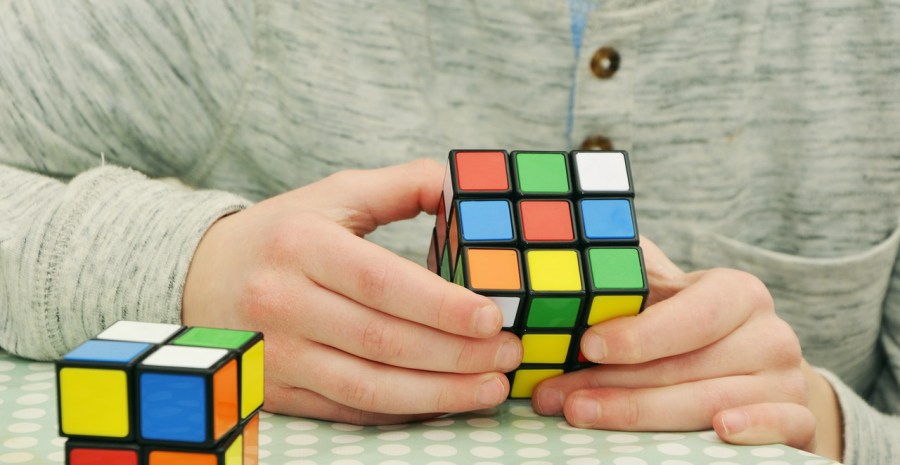How to Make Cubebot a Cube Again

Every cube has six equal sides. These are also known as faces or facets. Each cube has i face at the peak, one at the bottom, and four around the sides. Dice are examples of cubes, with each of the six sides having a number on it from one through half-dozen.
A cube is 3-dimensional. Information technology has 12 edges that are joined together by eight vertices, which are at the corners of the cube. Three sides encounter at every vertex. A cube is a hexahedron, significant information technology has vi faces. It'southward also a regular hexahedron, which means all six sides are equal is size. A cube is the just regular hexahedron.
A cube is also a platonic solid. Read on to find out what that ways and where cubes are plant in everyday life, architecture, art and nature.
What Is a Ideal Solid?
A ideal solid is a three-dimensional shape whose faces are polygons that take equal sides. In that location are five types of platonic solids:
- The tetrahedron (pyramid) has 3 faces.
- The hexahedron (cube) has four faces.
- The octahedron has five faces.
- The dodecahedron has 12 faces.
- The icosahedron has 20 faces.
All ideal solids are regular, meaning they have equal sides and angles, and each ane has an equal amount of sides meeting at every vertex. Each polygonal side is congruent, pregnant the size and shape of every side is identical.
Platonic solids were given their name considering of the studies of philosopher Plato. He attributed the shapes to burn, globe, air, h2o and the heavens and based his theory most the universe on them. The cube, according to Plato, was assigned to the earth because of its four-square regularity, according to Britannica.
E veryday Cubes
You come across cubes around yous every solar day. You put sugar cubes in your hot drinks and ice cubes in drinks to make them colder. Some tissue boxes are cube-shaped equally are some ornamental planters and ottomans. Babies and toddlers larn motor skills when they play with cube-shaped building blocks.
A famous cube is the Rubik's cube. Kids and adults alike love this cube-shaped puzzle. It was invented past a Hungarian professor of architecture named Ernõ Rubik in 1974. The Magic Cube, as Rubik first chosen information technology, is comprised of smaller cubes, and each side of the chief cube displays nine colored squares. What started out as a movable prototype to help his architecture students presently became a bestselling toy, leading to world championships in solving the puzzle, spin-off products and speedcubing.
C ubes in Architecture
The regular, symmetrical shape of a cube makes it easy to build with. Architects consider the geometrical blueprint to be a sign of perfection when it comes to structures. Many famous buildings take been designed in the shape of cubes.
The Mirrorcube is actually a hotel congenital in the trees in Sweden. The mirrored walls camouflage the accommodation amid its surroundings.
The Apple Cube is the iconic drinking glass cube archway to Apple tree'south flagship store on Fifth Avenue, New York City. Once you lot've entered the striking glass entrance, a spiral staircase leads you down into the store.
In Lyon, France, the Orange Cube sits on the banking company of the river, housing offices inside its intriguing blueprint. With giant-sized voids in the sides of the edifice, it almost looks as though someone has taken a bite or ii from it.
C ubes in Art
In the early 20th century, a revolutionary art movement called cubism was introduced by the artists George Braque and Pablo Picasso. The subject matter was comprised of cubes and various other geometrical shapes rather than being a true-to-life re-create of what was seen. It led the manner for abstract fine art and inspired creative art movements in the future, such every bit surrealism and futurism.
For brandish purposes in galleries and museums, the "white cube" is recognized for being the best surrounding to showcase artworks. The white, square walls foreclose your eyes from being distracted from the artwork hanging on them, helping to highlight the colors and details within them.
Drawing cubes as well helps with perspective in fine art and tin can go far easier to describe some items, such as figures. Artists likewise use cubes in artwork to draw the viewer's eye to a detail particular, such as light, shadow, colors or materials used.
C ubes in Nature
Information technology may seem foreign to think of cubes naturally occurring in nature due to their geometrical shape and rigid lines. Withal cubes in nature do be.
A mineral called pyrite is made of cuboidal crystals that result from two sulfur atoms bonding with an iron atom. Halite crystals are cubic as well, and you'll know this mineral better equally rock salt.
Possibly the about unusual example of cubes in nature is wombat poop. Wombats have incredibly dry feces due to their habitat. It's believed this helps proceed the cube structure intact when excreted, having been molded into a cube shape at the end of the abdominal tract.
Source: https://www.reference.com/world-view/many-sides-cube-e8f09baafbd0f960?utm_content=params%3Ao%3D740005%26ad%3DdirN%26qo%3DserpIndex
0 Response to "How to Make Cubebot a Cube Again"
Post a Comment